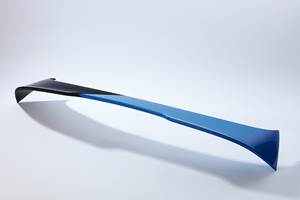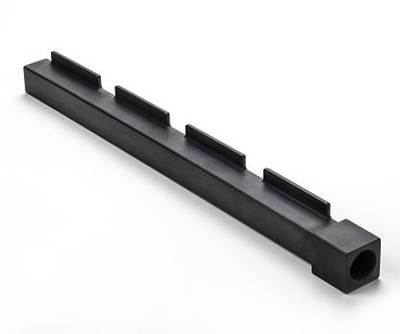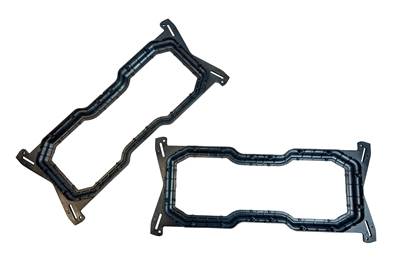Atop the Plastics Pyramid
Allegheny Performance Plastics specializes in molding parts from high-temperature resins for demanding applications as part of its mission to take on jobs ‘no one else does.’
In satellites, in jets, in automotive transmissions — the parts that Allegheny Performance Plastics molds for the roads, skies and outer space operate at the boundary of the harshest environments that plastics can inhabit. The list of materials that can survive in these environs is short, as is the list of molders that can successfully run them. Allegheny gladly, intentionally calls this rarefied air home. “We don’t like easy; we want difficult,” explains Robert Stutzman, Allegheny CEO. “We want something no one else does.”
One common means for organizing polymers that’s familiar to those in the industry is the “plastics pyramid.” From a large base of commodity resins, the pyramid builds upward, getting smaller as it goes with engineering plastics in the middle and high-temperature plastics — those with melt temperatures typically above 300°C (572°F) — occupying the smallest space at the pinnacle. Within this capstone, you find resins like PEEK, PEI, PPS, PI, PBI and PAI with familiar trade names such as Ultem, Ryton and Torlon. For these materials, Allegheny offers its customers assistance in selection, design optimization, sample production/testing and cost-competitive production.
“The key is that we can’t be everything to everyone,” Stutzman says. “So you focus on a certain type of material offering. The reason being that if you mold PP and PE, thousands of people in the country can do that. You use a commodity material, and you’re one of many — you become a commodity yourself.”
Early Innovators
Established in 1936, Allegheny Plastics Inc.’s initial focus was using plastics to print and laminate reusable charts. Based in Leetsdale, Penn., the Allegheny Performance Plastics division has been in injection molding since the 1960s. In 2016, Allegheny executives Greg Shoup and Shevey Westbrook, with the backing of two investment firms, completed a management buyout of the molding unit. Shoup and Westbrook remain at Allegheny, serving as chief technology officer and director of operations, respectively, with Stutzman hired on in October 2022 to act as CEO.

Allegheny Performance Plastics CEO Robert Stutzman and CTO Greg Shoup on the company’s molding floor, which applies lean and scientific molding principles. Photos: Allegheny Performance Plastics
Since Stutzman’s hiring, Allegheny has added a network of 17 external sales agents, and laid out a 5-year plan with four key pillars: people, where/how will the company grow, operational excellence and continuous improvement. To support this plan, the company is seeking to update its ERP program, and add other operations and manufacturing software, including MES, this year.
“We’re at the point now in our business that we need to be able to have some things integrated,” Stutzman says. “Not just ERP and MRP to handle our purchasing — we’re tight on space so we don’t want to have a warehouse full of stuff — but an MES system. I want data off the manufacturing floor and I want it all tied together. The business is going to grow and for us to maintain what we have — our performance financially but also for our customers — we can’t get bogged down doing stuff manually.”
“I want data off the manufacturing floor and I want it all tied together.”
Parts Potpourri
In the eight months he’s been on the job, Stutzman walks the floor every day, and virtually every day he has seen a new part in production as the company maintains several hundred active molds. When Plastics Technology visited, the manufacturing floor — which features 30 injection molding machines (mostly Nissei, ranging from 20 to 500 tons), seven CNC machining work cells for post-mold processing, and 40 ovens for post-curing parts molded from Solvay’s Torlon PAI resin — was humming with production of an array of parts. Seal rings; a satellite bound insert- and over-molded part; nylon gears and brake pistons; an Ultem transmission component; and an elastomer pad whose surface texture, imparted by the mold, imitates the grip of a gecko’s feet, were among just a few of the jobs in production.

A six-axis robot removes parts and adds inserts in an automated production cell.
Using high-temperature materials means that Allegheny runs oil through the molds instead of water, with longer cycles required and more expansion and contraction of the molds over time, demanding vigilance in preventive maintenance. How hot do these resins run? As we pass a hot runner temperature control unit in front of a press, the display’s set point reads 750°F.
“We don’t like easy; we want difficult. We want something no one else does.”
The manufacturing floor is divided into three “teams,” with all 19 presses in Team #2 utilizing RJG’s eDART process monitoring technology, with molds featuring temperature and pressure sensors. This team focuses on high-volume jobs, while Team #3 targets low-volume/high-mix jobs. Team #1 handles lower volume aerospace work. The Haas CNC machining centers are utilized to machine in part features post injection, where molding them in would have required more expensive tooling with longer lead times.
Running three shifts, Monday to Friday, with the occasional Saturday, Allegheny has roughly 50 employees, with the goal to be at 57 by the end of the year. Thanks to automation and process monitoring, Stutzman notes that in Team #2, two employees can keep tabs on 19 machines. All the workers on the floor are cross trained such that they can take on all the production roles: mold setup, process technician, inspection and more.
That inspection also happens on the floor simultaneous to production. In the middle of the molding cells, an inspection station (including a CMM), moisture analysis and more, resides. “It’s more about quality assurance than quality control,” Stutzman says. A lean manufacturing concept, this cell ensures good parts as they’re molded. Allegheny also operates a full quality control lab in a climate-controlled space off the molding floor.
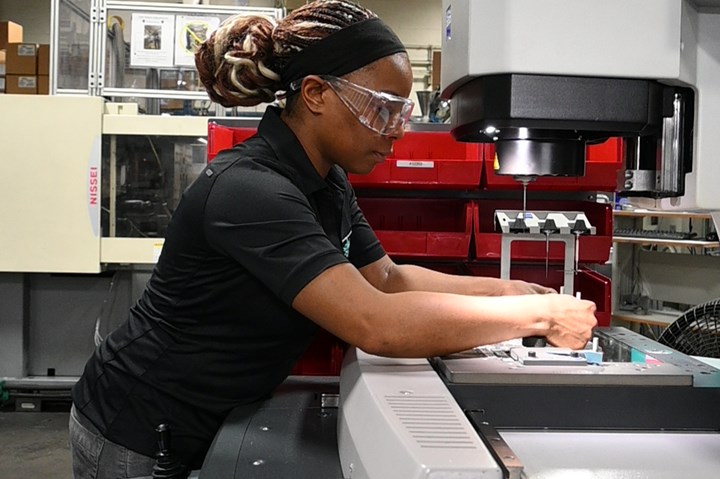
Allegheny performs some part inspection and validation on the molding floor simultaneously with part production.
Stutzman notes that on the floor and throughout the company, there is a culture of genuine teamwork, with no cliques. Over his 25-plus years in molding, he says he’s managed other production floors that operated socially more like a high school, making him feel like the principal.
Adjacent to the molding floor, Allegheny operates a full tool room with a handful of in-house mold builds each year. The molds that do come in, don’t leave, Stutzman says, with all the maintenance and tuning handled internally. In addition to three full-time toolmakers, the toolroom has an employee focused on preventive maintenance, with two younger employees — including an apprentice and a college student studying mechanical engineering — as Allegheny builds a bridge to the next generation of moldmakers.
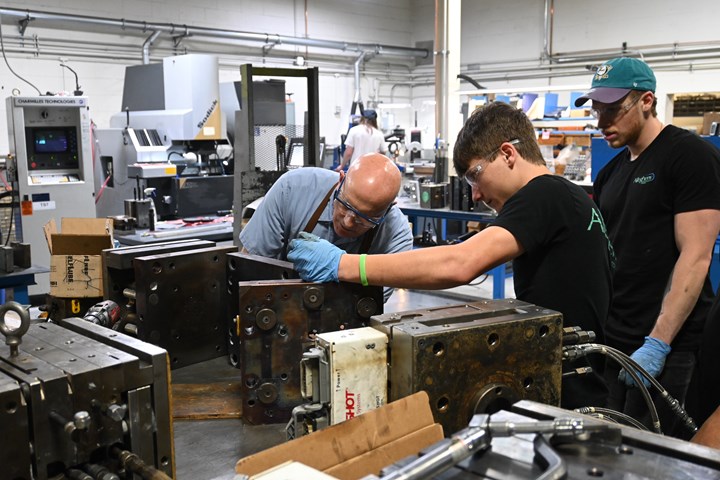
Allegheny’s toolroom has the capability to build new tools and maintain existing molds. Photo Credit: Allegheny Performance Plastics
Just off the plastics machining area, Allegheny houses its “skunk works,” a space for experimentation as well as validation. All new projects are scaled up here, ensuring a repeatable process is introduced to the molding floor once a tool goes into production. The company houses a polymer 3D printer here. For the materials and markets Allegheny works in, Stutzman says 3D printing for production isn’t currently viable, but it does use the machine to trial test fixtures, for instance, before creating final designs. This room also houses certified secondary cleaning processes for parts destined for outer space.
Treated like a clean room, Allegheny ultrasonically cleans, packs and ships parts, which can have no contamination. The final element of this room is dubbed the “supermarket.” Racks hold labeled blue bins full of parts that require some additional processing, typically machining, that workers pull from and refill based on a kanban system to track work in progress.
‘Geek Out’
Allegheny’s expertise in high-temperature materials has placed it at the forefront of metal-to-plastic conversion in the automotive and aerospace industries. Shoup — who’s been with Allegheny for 28 years, including the last 18 in the Performance Plastics molding division — has seen these plastics wins firsthand, and the impact they’ve had on Allegheny’s portfolio, with the 2009 recession and subsequent “transmission wars” in auto as an inflection point. Shoup estimates that, prior to the recession, Allegheny’s business broke 70/30 aerospace to automotive, while today those figures are flipped, as both markets grew overall with auto outpacing aero.
Allegheny’s expertise in high-temperature materials has placed it at the forefront of metal-to-plastic conversion in the automotive and aerospace industries.
“We developed experience in these high-temperature materials,” Stutzman says, “and aerospace presented the opportunity. Then in the ‘90s, automotive started to embrace polymers, especially in these critical wear opportunities. That business was slightly different — same materials and same technical challenges, but the scale was different.”
As an example, Allegheny points to a thrust washer it molds from Torlon that’s part of a hydrodynamic bearing for automotive transmissions. This part replaced a metal roller bearing and, to date, the company has made more than 100 million polymer thrust washers. In addition to lower weight and more design freedom (including possible part integration), polymers in applications like this offer lower NVH (noise vibration harshness) than metals, while resistance wise, the coefficient of friction is the same. In terms of wear, Allegheny says that, with proper hydrodynamic lift, polymers can provide unbeatable durability.

Molded from Solvay’s Torlon PAI resin, this thrust washer replaces metal within an automotive transmission.
Allegheny has invested in testing technologies to fully vet these materials and applications, including adding a differential scanning calorimetry (DSC) unit. Used in troubleshooting, the DSC can determine if a resin is contaminated or not what the supplier said it was. In particular, the DSC can be used to determine the polymer’s crystallization, melt and glass-transition temperatures.
Allegheny also recently converted a used piece of equipment into a friction and wear test stand, enabling it to perform lubricated and dry tribology testing. These capabilities and Allegheny’s extensive research database make it a sought-after partner of resin suppliers as they test new materials and applications. Its collaborations with Solvay over the years on the processing and functionality of Torlon have helped create best manufacturing practices for the specialized material.
Allegheny is IATF 1649, AS9100, ISO 9001 and ITAR (International Traffic in Arms Regulation) certified, in addition to earning Supplier Gold and Quality Clinic accreditation from United Technologies Corp. Aerospace Systems. These acknowledgments of capabilities will help lead the company’s next stage of growth as it pursues and wins jobs in electric vehicle charging, drones, UAVs and advanced missile systems. The company estimates that it currently has nearly 50,000 molded parts in space, with the number growing all the time.
All that those capabilities and in-house expertise are also reflected in Allegheny’s approach to new product and process development. “I use the phrase ‘geek out,’” Stutzman says. “There’s a technology there that created the excitement — the impetus to want to do something different — that’s really sort of the catalyst that drives (geeking out).”
When Stutzman was recruited to lead Allegheny, that curiosity and drive to try something new lent the company a highly appealing atmosphere. “There was this vibe to just get stuff done, move forward,” Stutzman says. “There was excitement, and it wasn’t like, ‘Oh my god, we won this job, and now we have to do it.’ There was this infectious desire to want to move forward.”
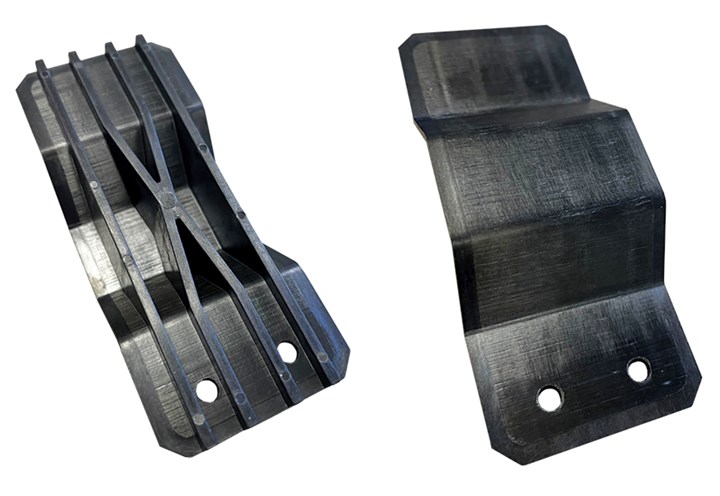
Working in collaboration with Solvay and Alpine Advanced Materials, Allegheny developed this test application dubbed TPC-IOM (thermoplastic composite injection overmolding) combining composite tape materials with an injection molded backing.
Related Content
Molder Repairs Platen Holes with Threaded Inserts
Automotive molder ITW Deltar Fasteners found new life for the battered bolt holes on its machine platens with a solution that’s designed to last.
Read MoreABC Technologies to Acquire Windsor Mold Group Technologies
The Tier One automotive supplier with compounding and blowmolding machine capabilities adds the 50-yr-old molder and moldmaker.
Read MoreCelanese to ‘Shine’ at CES 2023 with Expanded Portfolio of Materials
With it acquisition of DuPont’s engineering resins, Celanese’s resin solutions for automotive electrification, e-mobility and consumer electronics are plentiful.
Read MoreK 2022 Preview: Engineering Materials for Sustainability and E-Mobility
Materials that are sustainable yet offer equal performance to their fossil-based counterparts will be prominent at K 2022.
Read MoreRead Next
Drones and Injection Molding Ready for Takeoff
Drones and unmanned aerial vehicles (UAV) are approaching an inflection point where their production volumes — and functionality — will increasingly point to injection molding.
Read MoreSolvay's PEEK Chosen for Oil Scavenger Line in Polimotor 2
The Polimotor 2 all-plastic engine project for competitive auto racing is moving right along with Solvay's materials playing a key role.
Read MoreUnmanned Aerial System (UAS) Applies Injection Molded Chassis
BlueHalo’s Intense Eye UAS has replaced a machined aerospace-grade aluminum chassis with one molded from Alpine Advanced Materials’ HX5 multi-scale reinforced polymer for a stronger, lighter craft.
Read More



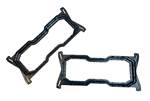






.png;maxWidth=300;quality=90)















